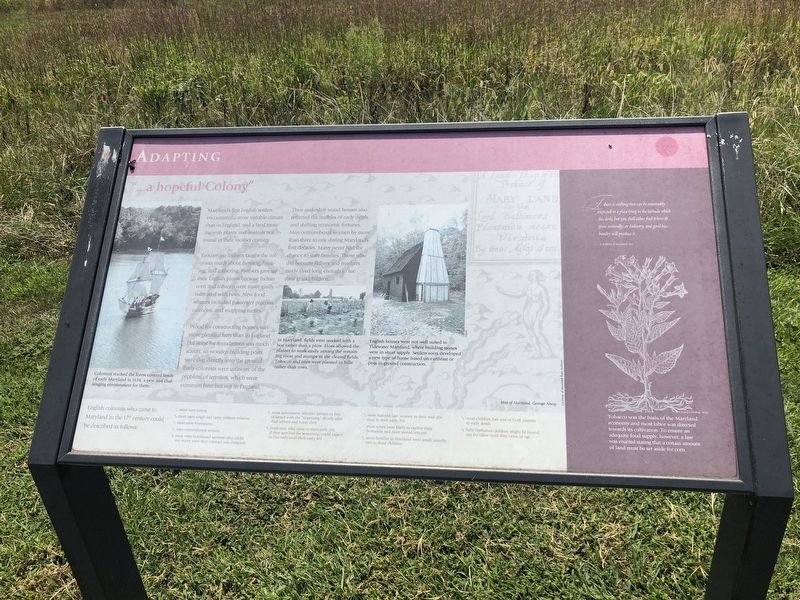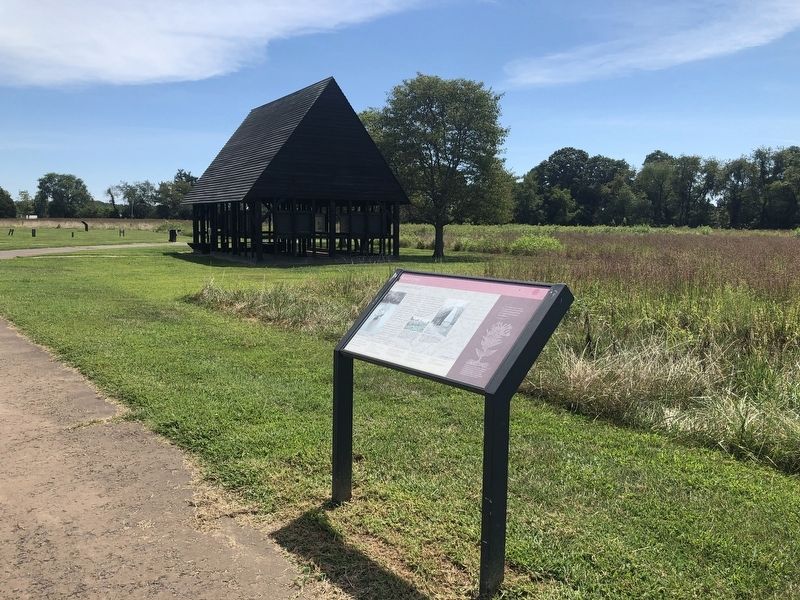St. Mary's City in St. Mary's County, Maryland — The American Northeast (Mid-Atlantic)
"...a hopeful Colony"
Adapting
Yaocomaco Indians taught the colonists much about farming, hunting, and gathering. Farmers gave up their English plows because Indian corn and tobacco were more easily cultivated with hoes. New food sources included passenger pigeons, raccoons, and snapping turtles.
Wood for constructing houses was more plentiful here than in England but stone for foundations was much scarcer, so wooden building posts were dug directly into the ground. Early colonists were unaware of the problem of termites, which were common here but not in England.
Their makeshift wood homes also reflected the realities of early death and shifting economic fortunes. Men outnumbered women by more than three to one during Maryland's first decades. Many never had the chance to start families. Those who did become fathers and mothers rarely lived long enough to see their grandchildren.
[Captions:]
Colonists reached the forest-covered lands of early Maryland in 1634, a new and challenging environment for them.
In Maryland, fields were worked with a hoe rather than a plow. Hoes allowed the planter to work easily among the remaining roots and stumps in the cleared fields. Tobacco and corn were planted in hills rather than in rows.
English houses were not well suited to Tidewater Maryland, where building stones were in short supply. Settlers soon developed a new type of house based on earthfast or post-in-ground construction.
English colonists who came to Maryland in the 17th century could be described as follows:
• most were young
• most were single and came without relatives
• most were Protestants
• men outnumbered women
• most were indentured servants who could not marry until their contract was complete
• most newcomers, whether servant or free, sickened with the "seasoning" shortly after they arrived and many died
• most men who came in their early 20s, if they survived the seasoning, could expect to live only until their early 40s • most married late: women in their mid-20s; men in their early 30s
• most wives were likely to outlive their husbands and most would remarry
• most families in Maryland were small; usually two to three children
• most children lost one or both parents to early death
• fully orphaned children might be bound out for labor until they came of age
[Aside:]
"...there is nothing that can be reasonably expected in a place lying in the latitude which this doth,
A Relation of Maryland, 1635
Tobacco was the basis of the Maryland economy and most labor was directed toward its cultivation. To ensure an adequate food supply, however, a law was enacted stating that a certain amount of land must be set aside for corn.
Erected by Historic St. Mary's City.
Topics. This historical marker is listed in these topic lists: Agriculture • Colonial Era • Native Americans • Settlements & Settlers. A significant historical year for this entry is 1634.
Location. 38° 11.004′ N, 76° 25.726′ W. Marker is in St. Mary's City, Maryland, in St. Mary's County. Marker can be reached from Point Lookout Road (Maryland Route 5) 0.4 miles west of Rosecroft Road, on the left when traveling west. Touch for map. Marker is at or near this postal address: 16721 Point Lookout Road, Saint Marys City MD 20686, United States of America. Touch for directions.
Other nearby markers. At least 8 other markers are within walking distance of this marker. Shock Troops of the Counter-Reformation (within shouting distance of this marker); Andrew White, Apostle to Maryland (within shouting distance of this marker); "…buried…in a most solemn manner" (within shouting distance of this marker); Project Lead Coffins (within shouting distance of this marker); Putting Together the Pieces (within shouting distance of this marker); The "Priests' House" (within shouting distance of this marker); The Chapel Architecture (within shouting distance of this marker); An End of Freedom but Persistence of Faith (within shouting distance of this marker). Touch for a list and map of all markers in St. Mary's City.
Credits. This page was last revised on September 2, 2019. It was originally submitted on September 2, 2019, by Devry Becker Jones of Washington, District of Columbia. This page has been viewed 109 times since then and 9 times this year. Photos: 1, 2. submitted on September 2, 2019, by Devry Becker Jones of Washington, District of Columbia.

